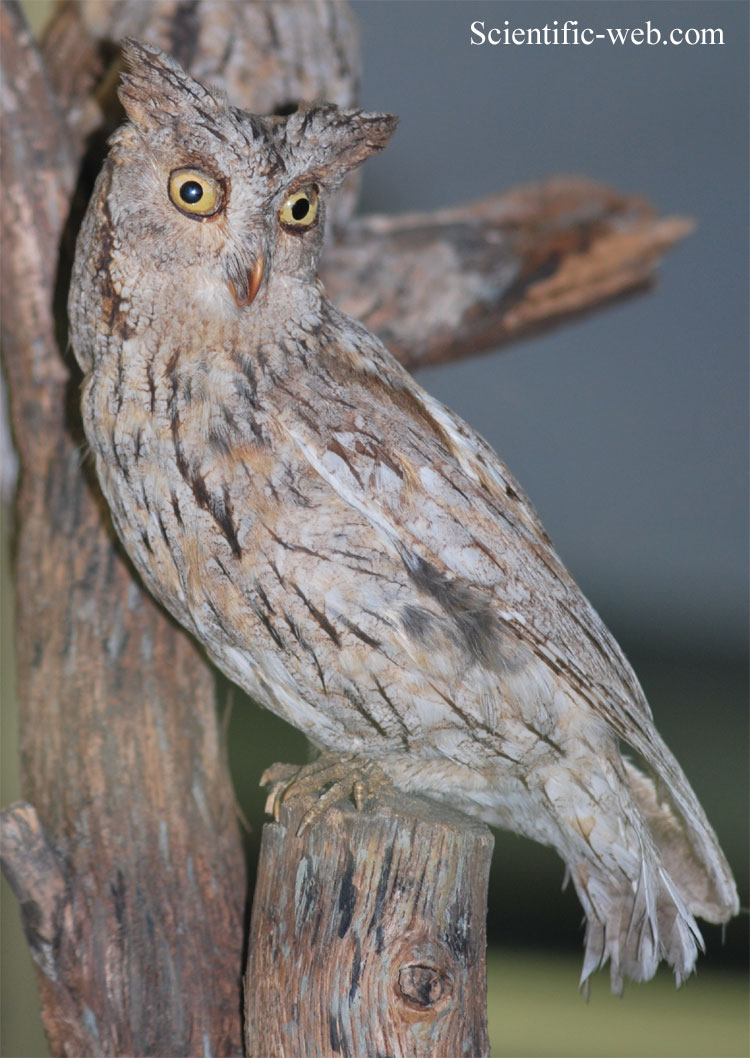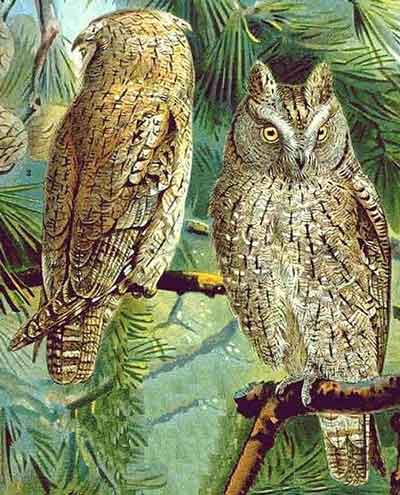
Otus scops, Photo: Michael Lahanas
Superregnum: Eukaryota
Cladus: Unikonta
Cladus: Opisthokonta
Cladus: Holozoa
Regnum: Animalia
Subregnum: Eumetazoa
Cladus: Bilateria
Cladus: Nephrozoa
Superphylum: Deuterostomia
Phylum: Chordata
Subphylum: Vertebrata
Infraphylum: Gnathostomata
Megaclassis: Osteichthyes
Cladus: Sarcopterygii
Cladus: Rhipidistia
Cladus: Tetrapodomorpha
Cladus: Eotetrapodiformes
Cladus: Elpistostegalia
Superclassis: Tetrapoda
Cladus: Reptiliomorpha
Cladus: Amniota
Classis: Reptilia
Cladus: Eureptilia
Cladus: Romeriida
Subclassis: Diapsida
Cladus: Sauria
Infraclassis: Archosauromorpha
Cladus: Crurotarsi
Divisio: Archosauria
Cladus: Avemetatarsalia
Cladus: Ornithodira
Subtaxon: Dinosauromorpha
Cladus: Dinosauriformes
Cladus: Dracohors
Cladus: Dinosauria
Cladus: Saurischia
Cladus: Eusaurischia
Subordo: Theropoda
Cladus: Neotheropoda
Cladus: Averostra
Cladus: Tetanurae
Cladus: Avetheropoda
Cladus: Coelurosauria
Cladus: Tyrannoraptora
Cladus: Maniraptoromorpha
Cladus: Maniraptoriformes
Cladus: Maniraptora
Cladus: Pennaraptora
Cladus: Paraves
Cladus: Eumaniraptora
Cladus: Avialae
Infraclassis: Aves
Cladus: Avebrevicauda
Cladus: Pygostylia
Cladus: Ornithothoraces
Cladus: Ornithuromorpha
Cladus: Carinatae
Parvclassis: Neornithes
Cohors: Neognathae
Cladus: Neoaves
Ordo: Strigiformes
Familia: Strigidae
Subfamilia: Striginae
Genus: Otus
Species: Otus scops
Subspecies: O. s. cycladum - O. s. cyprius - O. s. mallorcae - O. s. pulchellus - O. s. scops - O. s. turanicus - O. s. vincii
Name
Otus scops (Linnaeus, 1758)
Synonyms
Strix scops (protonym)
References
Primary references
Linnaeus, C. 1758. Systema Naturae per regna tria naturae, secundum classes, ordines, genera, species, cum characteribus, differentiis, synonymis, locis. Editio Decima, Reformata. Tomus I. Holmiæ (Stockholm): impensis direct. Laurentii Salvii. 824 pp. DOI: 10.5962/bhl.title.542 BHL p. 92 BHL Reference page.
Vernacular names
aragonés: Cholibeta
беларуская: Сплюшка звычайная
български: Чухал
čeština: Výreček malý
dansk: Dværghornugle
Deutsch: Zwergohreule
Ελληνικά: Γκιώνης, Θουπί
English: Eurasian Scops-Owl
Esperanto: Malgranda orelstrigo
español: Autillo europeo
suomi: Kyläpöllönen
français: Petit-duc scops
galego: Moucho de orellas
עברית: שעיר מצוי
magyar: Füleskuvik
հայերեն: Բվիկ եվրոպական
italiano: Assiolo
日本語: ヨーロッパコノハズク
한국어: 소쩍새
lietuvių: Apuokėlis
Bahasa Melayu: Burung Hantu Kuang Kuit
Nederlands: Dwergooruil
norsk: Dverghornugle
polski: Syczek
português: Mocho-d’orelhas
русский: Сплюшка
slovenčina: Výrik lesný
slovenščina: Veliki skovik
svenska: Dvärguv
українська: Совка сплюха

Otus scops (*)
The Eurasian scops owl (Otus scops), also known as the European scops owl or just scops owl, is a small owl in the typical owl family Strigidae. Its breeding range extends from southern Europe eastwards to southern Siberia and the western Himalayas. It is migratory, wintering in Africa south of the Sahara.
Taxonomy
The Eurasian scops owl was formally described by Swedish naturalist Carl Linnaeus in 1758 in the tenth edition of his Systema Naturae. Linnaeus cited the 1599 description by the Italian naturalist Ulisse Aldrovandi, placed it with all the other owls in the genus Strix and coined the binomial name Strix scops.[4][5] The Eurasian scops owl is now placed in the genus Otus that was introduced in 1769 by Welsh naturalist Thomas Pennant.[6][7] The genus name is derived from the Latin otus meaning "eared owl". The specific epithet scops is from the Ancient Greek word skōps for a little eared owl.[8] The term is believed to be of Pre-Greek origin; folk etymology links it to σκώπτω (skṓptō, "to mock") or σκέπτομαι (sképtomai, "to examine").[9]
Five subspecies are recognised:[7]
O. s. scops (Linnaeus, 1758) – France and Italy to the Caucasus area
O. s. mallorcae von Jordans, 1923 – Iberian Peninsula, Balearic Islands and northwest Africa
O. s. cycladum (Tschusi, 1904) – southern Greece and Crete to southern Turkey, Syria and Jordan
O. s. turanicus (Loudon, 1905) – Iraq to northwest Pakistan
O. s. pulchellus (Pallas, 1771) – Kazakhstan to southern Siberia and western Himalayas
Description
The Eurasian scops owl is 19–21 cm (7.5–8.3 in) in length with a wingspan of 47–54 cm (19–21 in). This is somewhat smaller than the little owl (Athene noctua). It perches upright and shows small ear-tufts. The plumage is predominantly grey-brown in colour, with a paler face, underparts and shoulder line. This species has a strong direct flight on long narrow wings, reflecting its migratory habits.[10]
The call is a deep whistle given by both sexes. It is similar to the call of midwife toads in the genus Alytes.[10]
Distribution and habitat
Egg, Collection Museum Wiesbaden
This bird breeds in southern Europe eastwards into western and central Asia. It is migratory, wintering in southernmost Europe and sub-Saharan Africa. It was spotted in Newtown area near Kolkata for a brief period during October 2021. It was the first sighting in eastern India.[11] It is rare any distance north of its breeding range, usually occurring as a spring overshoot. It is unlikely that this nocturnal owl would be found outside the breeding season when it is not calling.
Behaviour
Breeding
Eurasian scops owls breed in open woodland, parks and gardens. The nest is usually a hole in a tree or in a wall, but can sometimes be an old nest of another species such as a crow. The clutch is usually 4 or 5 eggs. These are white and measure 31 mm × 27 mm (1.2 in × 1.1 in) and weigh around 13 g (0.46 oz). The eggs are incubated only by the female. They hatch after 24-25 days. The young are cared for and fed by both parents. They fledge when aged 21–29 days and become independent of their parents at 30–40 days of age.[12]
Diet
It takes small prey such as insects and other invertebrates. It is largely nocturnal.
Grey morph
References
BirdLife International (2019). "Otus scops". IUCN Red List of Threatened Species. 2019: e.T155019854A155020110. doi:10.2305/IUCN.UK.2019-3.RLTS.T155019854A155020110.en. Retrieved 12 November 2021.
"Appendices | CITES". cites.org. Retrieved 2022-01-14.
For Scops giu see for instance: Powys, 4th Baron Lilford, Thomas Littleton; Salvin, Osbert; Newton, Alfred; Keulemans, John Gerrard (1885). Coloured figures of the birds of the British Islands. Vol. 1. London: R.H. Porter. pp. 98f. OCLC 1029665771. Retrieved 2020-05-15.
Linnaeus, Carl (1758). Systema Naturae per regna tria naturae, secundum classes, ordines, genera, species, cum characteribus, differentiis, synonymis, locis (in Latin). Vol. 1 (10th ed.). Holmiae (Stockholm): Laurentii Salvii. p. 92.
Aldrovandi, Ulisse (1599). Vlyssis Aldrovandi philosophi ac medici Bononiensis historiam naturalem in gymnasio Bononiensi profitentis, Ornithologiae (in Latin). Vol. 1. Bononiae (Bologna, Italy): Franciscum de Franciscis Senensem. pp. 561–567, Liber 8, Cap. 4.
Pennant, Thomas (1769). "Otus bakkamoena". Indian Zoology. London. p. 3.
Gill, Frank; Donsker, David; Rasmussen, Pamela, eds. (January 2022). "Owls". IOC World Bird List Version 12.1. International Ornithologists' Union. Retrieved 2 March 2022.
Jobling, James A. (2010). The Helm Dictionary of Scientific Bird Names. London: Christopher Helm. pp. 286, 351. ISBN 978-1-4081-2501-4.
Beekes, Robert S. P. (2010) Etymological Dictionary of Greek (Leiden Indo-European Etymological Dictionary Series; 10)[1], with the assistance of Lucien van Beek, Leiden, Boston: Brill, →ISBN, page 1365
Svensson, Lars; Mullarney, Killian; Zetterström, Dan (2009). Collins Bird Guide (2nd ed.). London: HarperCollins. p. 232. ISBN 978-0-00-726814-6.
Sengupta, Snehal (28 October 2021). "Rare owl sighting in New Town". No. The Telegraph. ABP. Retrieved 8 January 2022.
Cramp 1985, pp. 462–463.
Sources
Cramp, Stanley, ed. (1985). "Otus scops Scops Owl". Handbook of the Birds of Europe the Middle East and North Africa. The Birds of the Western Palearctic. Vol. IV: Terns to Woodpeckers. Oxford: Oxford University Press. pp. 454–465. ISBN 978-0-19-857507-8.
External links
Media related to Otus scops at Wikimedia Commons
Blasco-Zumeta, Javier; Heinze, Gerd-Michael. "Eurasian Scops Owl" (PDF). Identification Atlas of Aragon's Birds.
Retrieved from "http://en.wikipedia.org/"
All text is available under the terms of the GNU Free Documentation License

